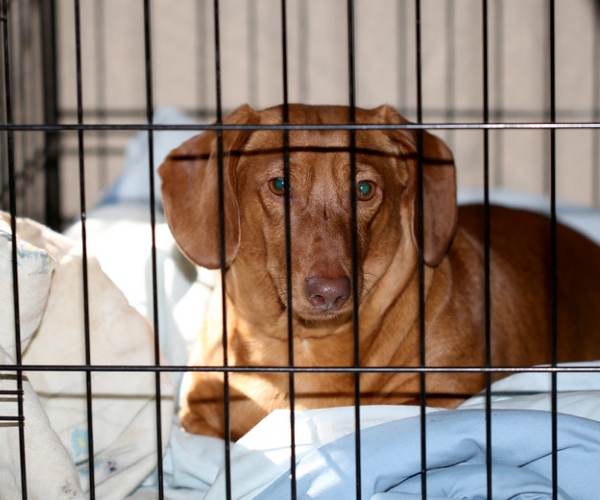Do you want to give your dog the best possible care, but feel hesitant about crate training because of the negative stigma surrounding it? Unsure if crate training is cruel? If so, you’re not alone.
Many dog owners cringe at the idea of confining their fur baby to a crate. At one point in time, I was one of those pet parents.
So, is crate training cruel?
The truth is, crate training is not cruel when done properly and can be a valuable tool in ensuring a happy, healthy dog, and a harmonious household. Crate training creates a safe space for your dog, helps with potty training, reduces stress and anxiety, can prevent destructive behavior and gives you peace of mind.
In this blog post, I’ll share with you why crate training is beneficial for both you and your pup, how to properly introduce your dog to the crate, and common mistakes to avoid.
So let’s bust the myth that crate training is cruel, and discover the truth behind this training technique…
Crate Training Creates a Safe Space for Your Dog
One of the main benefits of crate training your dog is that it creates a safe space for them to call their own.
You may have noticed your dog run and hide under the bed, table or even behind the sofa when they are scared or even just to sleep…
Dogs are den animals by nature and they are naturally drawn towards small, confined spaces where they can feel secure. A crate provides just that, and can become a cozy and comforting space for your dog to relax and retreat to.
Introducing your dog to the crate properly is key to ensuring they see it as a safe space. By making the crate a positive and rewarding environment, your dog will begin to associate it with feelings of comfort and security. We will dive into this a little more in a minute.

Crate Training Helps with Potty Training
Dogs have a natural instinct to keep their sleeping area clean, and crate training takes advantage of that instinct to help with potty training.
By confining your dog to a crate, you are teaching them to hold their pee and poo until it’s time to go outside. This also prevent accidents in the house and speeds up the potty training process.
Be sure to let your dog out for regular potty breaks and do not to leave them in the crate for too long. After your dog goes potty outside, bring them in and give them some play time before crating them again.
A general rule of thumb is that puppies can hold their bladder for approximately one hour for each month of age, but this may vary depending on the dog. For example, a 3-month-old puppy can typically hold their bladder for up to 3 hours, while a 6-month-old puppy can hold it for up to 6 hours.
Crate Training Reduces Anxiety and Stress
By creating a positive association with the crate, you can actually help to reduce your dog’s anxiety and stress levels. When a dog feels nervous or overwhelmed, having a safe and familiar place to retreat to can make all the difference.
Crate training provides your dog with a sense of security and comfort, much like a den in the wild. By gradually introducing your dog to the crate and using positive reinforcement techniques, you can help them to feel at ease in their space.
This can be especially helpful for dogs who struggle with separation anxiety or who become anxious in new environments.
Many vets and dog trainers will recommend crate training as a way to reduce stress in dogs.
By providing a familiar and controlled space, you can help your dog feel more calm and relaxed in a variety of situations.
Crate Training Can Help Prevent Destructive Behavior
Crate training can actually be a very effective tool in preventing destructive behavior in dogs.
Dogs who are not properly trained to stay in a crate may develop destructive habits when left unsupervised, such as chewing on furniture, digging in the carpet, or even chewing on themselves.
However, crate training can provide a safe and secure space for your dog to relax and feel comfortable, especially when you’re not home to supervise them.
Crate Training Gives You Peace of Mind
Crate training your dog can also provide you with peace of mind when you are away from home or too busy to keep a close eye on your dog.
It keeps you from worrying about what your dog is getting into when you are gone. You don’t have to worry if your dog is chewing things when they are anxious or bored. You also don’t have to worry about them getting into things they shouldn’t be or using the bathroom inside.
The same goes for when you are too busy.

I’ve come home to a mess like this once. My dog had a pillow destroyed from one side of my house to the other. Trust me, it isn’t fun!
It can also give you peace of mind (and your guests) when you have visitors over, especially if your dog doesn’t behave appropriately when you have visitors.
RELATED===> 5 Expert Tips for Getting Your Dog to Listen When you Have Visitors!
How to Properly Introduce Your Dog to Crate Training
Understanding the various benefits of crate training your dog is essential, but knowing how to introduce your dog to the crate properly is equally important. The first step is to choose a crate that’s the right size for your pup and comfortable for them to rest in.
The crate should be big enough for them to stand and turn around comfortably, but not so large that they can use one end as a bathroom.
Next, it’s important to create a positive association with the crate. Start by placing toys and treats inside to encourage your dog to explore the space.
RELATED===> 6 Things to Never Put in Your Dog’s Crate and Why!
You can even feed them their meals near or inside the crate (while you are watching them) or put their favorite blanket or a shirt with your scent on it inside to make it feel like a cozy den.
It’s super important to make the crate a positive, safe space for your pup.
You should never use it as a punishment or leave your dog inside for extended periods without regular breaks to stretch and relieve themselves!
Gradually increase the length of time your dog spends inside the crate over several days, starting with just a few minutes and building up as they become more comfortable.
RELATED===> How to Crate Train a Dog Successfully: The Ultimate Guide!
By following these steps, you’ll be able to introduce your dog to their crate in a positive way, help them establish boundaries, and promote good behavior.
Common Mistakes to Avoid When Crate Training
While crate training can be an effective tool for providing your pup with a safe and comfortable space, there are a few common mistakes you should avoid during the process.
Never use the crate as a form of punishment. If your dog associates the crate with negative experiences, they may become fearful and hesitant to enter it.
Never leave your dog inside the crate for too long without breaks. Dogs, especially puppies, need regular breaks to stretch, move around, and go potty.
Avoid introducing the crate too quickly or aggressively. Gradual acclimation is key. Start by placing treats or toys inside the crate and inviting and encourage your dog to explore. Sit beside the crate and show excitement in your voice.
Then, gradually increase the amount of time they spend in the crate over several days. This will help them establish positive associations with the space.
Lastly, it’s important to choose the right size crate for your pup. A crate that is too small will be uncomfortable and stressful, while one that is too large may not feel secure and will cause your dog to have an accident in the crate.
RELATED===> Why is my Puppy Peeing in the Crate? Here’s Why and How to Stop it!
The crate should be large enough for your pup to stand up, turn around, and lie down comfortably, but not much bigger than that.
By avoiding these common mistakes and following the positive, gradual approach I’ve shared with you, crate training can be a successful and rewarding experience for both you and your fur baby.
Conclusion
Crate training is not cruel or inhumane as many people think.
Instead, it can benefit both you and your dog by creating a safe space, aiding in potty training, reducing stress and anxiety, preventing destructive behavior, and it provides you with peace of mind.
Introducing the crate correctly and avoiding common mistakes is essential to making the most out of this valuable tool. With consistency, patience, and positive reinforcement, your dog will learn to appreciate their crate and see it as a safe haven.
Remember, as Cesar Millan once said, “A dog crate, like any other tool, is neither good nor bad in itself. It’s how you use it that determines whether it’s humane or inhumane.”
If you have any questions or comments, leave them below. If you found this post helpful, let me know or give it a share.

